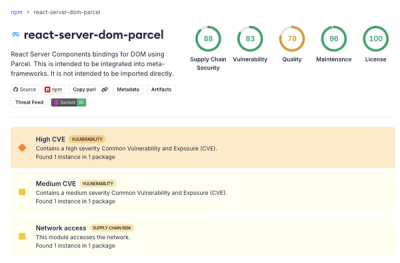
Security News
Deno 2.6 + Socket: Supply Chain Defense In Your CLI
Deno 2.6 introduces deno audit with a new --socket flag that plugs directly into Socket to bring supply chain security checks into the Deno CLI.
youtube-transcript-api
Advanced tools
This is an python API which allows you to get the transcripts/subtitles for a given YouTube video. It also works for automatically generated subtitles, supports translating subtitles and it does not require a headless browser, like other selenium based solutions do!
This is a python API which allows you to retrieve the transcript/subtitles for a given YouTube video. It also works for automatically generated subtitles, supports translating subtitles and it does not require a headless browser, like other selenium based solutions do!
Maintenance of this project is made possible by all the contributors and sponsors. If you'd like to sponsor this project and have your avatar or company logo appear below click here. 💖
It is recommended to install this module by using pip:
pip install youtube-transcript-api
You can either integrate this module into an existing application or just use it via a CLI.
The easiest way to get a transcript for a given video is to execute:
from youtube_transcript_api import YouTubeTranscriptApi
ytt_api = YouTubeTranscriptApi()
ytt_api.fetch(video_id)
Note: By default, this will try to access the English transcript of the video. If your video has a different language, or you are interested in fetching a transcript in a different language, please read the section below.
Note: Pass in the video ID, NOT the video URL. For a video with the URL
https://www.youtube.com/watch?v=12345the ID is12345.
This will return a FetchedTranscript object looking somewhat like this:
FetchedTranscript(
snippets=[
FetchedTranscriptSnippet(
text="Hey there",
start=0.0,
duration=1.54,
),
FetchedTranscriptSnippet(
text="how are you",
start=1.54,
duration=4.16,
),
# ...
],
video_id="12345",
language="English",
language_code="en",
is_generated=False,
)
This object implements most interfaces of a List:
ytt_api = YouTubeTranscriptApi()
fetched_transcript = ytt_api.fetch(video_id)
# is iterable
for snippet in fetched_transcript:
print(snippet.text)
# indexable
last_snippet = fetched_transcript[-1]
# provides a length
snippet_count = len(fetched_transcript)
If you prefer to handle the raw transcript data you can call fetched_transcript.to_raw_data(), which will return
a list of dictionaries:
[
{
'text': 'Hey there',
'start': 0.0,
'duration': 1.54
},
{
'text': 'how are you',
'start': 1.54
'duration': 4.16
},
# ...
]
You can add the languages param if you want to make sure the transcripts are retrieved in your desired language
(it defaults to english).
YouTubeTranscriptApi().fetch(video_id, languages=['de', 'en'])
It's a list of language codes in a descending priority. In this example it will first try to fetch the german
transcript ('de') and then fetch the english transcript ('en') if it fails to do so. If you want to find out
which languages are available first, have a look at list().
If you only want one language, you still need to format the languages argument as a list
YouTubeTranscriptApi().fetch(video_id, languages=['de'])
You can also add preserve_formatting=True if you'd like to keep HTML formatting elements such as <i> (italics)
and <b> (bold).
YouTubeTranscriptApi().fetch(video_ids, languages=['de', 'en'], preserve_formatting=True)
If you want to list all transcripts which are available for a given video you can call:
ytt_api = YouTubeTranscriptApi()
transcript_list = ytt_api.list(video_id)
This will return a TranscriptList object which is iterable and provides methods to filter the list of transcripts for
specific languages and types, like:
transcript = transcript_list.find_transcript(['de', 'en'])
By default this module always chooses manually created transcripts over automatically created ones, if a transcript in
the requested language is available both manually created and generated. The TranscriptList allows you to bypass this
default behaviour by searching for specific transcript types:
# filter for manually created transcripts
transcript = transcript_list.find_manually_created_transcript(['de', 'en'])
# or automatically generated ones
transcript = transcript_list.find_generated_transcript(['de', 'en'])
The methods find_generated_transcript, find_manually_created_transcript, find_transcript return Transcript
objects. They contain metadata regarding the transcript:
print(
transcript.video_id,
transcript.language,
transcript.language_code,
# whether it has been manually created or generated by YouTube
transcript.is_generated,
# whether this transcript can be translated or not
transcript.is_translatable,
# a list of languages the transcript can be translated to
transcript.translation_languages,
)
and provide the method, which allows you to fetch the actual transcript data:
transcript.fetch()
This returns a FetchedTranscript object, just like YouTubeTranscriptApi().fetch() does.
YouTube has a feature which allows you to automatically translate subtitles. This module also makes it possible to
access this feature. To do so Transcript objects provide a translate() method, which returns a new translated
Transcript object:
transcript = transcript_list.find_transcript(['en'])
translated_transcript = transcript.translate('de')
print(translated_transcript.fetch())
from youtube_transcript_api import YouTubeTranscriptApi
ytt_api = YouTubeTranscriptApi()
# retrieve the available transcripts
transcript_list = ytt_api.list('video_id')
# iterate over all available transcripts
for transcript in transcript_list:
# the Transcript object provides metadata properties
print(
transcript.video_id,
transcript.language,
transcript.language_code,
# whether it has been manually created or generated by YouTube
transcript.is_generated,
# whether this transcript can be translated or not
transcript.is_translatable,
# a list of languages the transcript can be translated to
transcript.translation_languages,
)
# fetch the actual transcript data
print(transcript.fetch())
# translating the transcript will return another transcript object
print(transcript.translate('en').fetch())
# you can also directly filter for the language you are looking for, using the transcript list
transcript = transcript_list.find_transcript(['de', 'en'])
# or just filter for manually created transcripts
transcript = transcript_list.find_manually_created_transcript(['de', 'en'])
# or automatically generated ones
transcript = transcript_list.find_generated_transcript(['de', 'en'])
RequestBlocked or IpBlocked exception)Unfortunately, YouTube has started blocking most IPs that are known to belong to cloud providers (like AWS, Google Cloud
Platform, Azure, etc.), which means you will most likely run into RequestBlocked or IpBlocked exceptions when
deploying your code to any cloud solutions. Same can happen to the IP of your self-hosted solution, if you are doing
too many requests. You can work around these IP bans using proxies. However, since YouTube will ban static proxies
after extended use, going for rotating residential proxies provide is the most reliable option.
There are different providers that offer rotating residential proxies, but after testing different offerings I have found Webshare to be the most reliable and have therefore integrated it into this module, to make setting it up as easy as possible.
Once you have created a Webshare account and purchased a
"Residential" proxy package that suits your workload (make sure NOT to purchase "Proxy Server" or
"Static Residential"!), open the
Webshare Proxy Settings to retrieve
your "Proxy Username" and "Proxy Password". Using this information you can initialize the YouTubeTranscriptApi as
follows:
from youtube_transcript_api import YouTubeTranscriptApi
from youtube_transcript_api.proxies import WebshareProxyConfig
ytt_api = YouTubeTranscriptApi(
proxy_config=WebshareProxyConfig(
proxy_username="<proxy-username>",
proxy_password="<proxy-password>",
)
)
# all requests done by ytt_api will now be proxied through Webshare
ytt_api.fetch(video_id)
Using the WebshareProxyConfig will default to using rotating residential proxies and requires no further
configuration.
You can also limit the pool of IPs that you will be rotating through to those located in specific countries. By choosing locations that are close to the machine that is running your code, you can reduce latency. Also, this can be used to work around location-based restrictions.
ytt_api = YouTubeTranscriptApi(
proxy_config=WebshareProxyConfig(
proxy_username="<proxy-username>",
proxy_password="<proxy-password>",
filter_ip_locations=["de", "us"],
)
)
# Webshare will now only rotate through IPs located in Germany or the United States!
ytt_api.fetch(video_id)
You can find the full list of available locations (and how many IPs are available in each location) here.
Note that referral links are used here and any purchases made through these links will support this Open Source project (at no additional cost of course!), which is very much appreciated! 💖😊🙏💖
However, you are of course free to integrate your own proxy solution using the GenericProxyConfig class, if you
prefer using another provider or want to implement your own solution, as covered by the following section.
Alternatively to using Webshare, you can set up any generic HTTP/HTTPS/SOCKS proxy using the
GenericProxyConfig class:
from youtube_transcript_api import YouTubeTranscriptApi
from youtube_transcript_api.proxies import GenericProxyConfig
ytt_api = YouTubeTranscriptApi(
proxy_config=GenericProxyConfig(
http_url="http://user:pass@my-custom-proxy.org:port",
https_url="https://user:pass@my-custom-proxy.org:port",
)
)
# all requests done by ytt_api will now be proxied using the defined proxy URLs
ytt_api.fetch(video_id)
Be aware that using a proxy doesn't guarantee that you won't be blocked, as YouTube can always block the IP of your proxy! Therefore, you should always choose a solution that rotates through a pool of proxy addresses, if you want to maximize reliability.
When initializing a YouTubeTranscriptApi object, it will create a requests.Session which will be used for all
HTTP(S) request. This allows for caching cookies when retrieving multiple requests. However, you can optionally pass a
requests.Session object into its constructor, if you manually want to share cookies between different instances of
YouTubeTranscriptApi, overwrite defaults, set custom headers, specify SSL certificates, etc.
from requests import Session
http_client = Session()
# set custom header
http_client.headers.update({"Accept-Encoding": "gzip, deflate"})
# set path to CA_BUNDLE file
http_client.verify = "/path/to/certfile"
ytt_api = YouTubeTranscriptApi(http_client=http_client)
ytt_api.fetch(video_id)
# share same Session between two instances of YouTubeTranscriptApi
ytt_api_2 = YouTubeTranscriptApi(http_client=http_client)
# now shares cookies with ytt_api
ytt_api_2.fetch(video_id)
Some videos are age restricted, so this module won't be able to access those videos without some sort of authentication. Unfortunately, some recent changes to the YouTube API have broken the current implementation of cookie based authentication, so this feature is currently not available.
Formatters are meant to be an additional layer of processing of the transcript you pass it. The goal is to convert a
FetchedTranscript object into a consistent string of a given "format". Such as a basic text (.txt) or even formats
that have a defined specification such as JSON (.json), WebVTT (.vtt), SRT (.srt), Comma-separated format
(.csv), etc...
The formatters submodule provides a few basic formatters, which can be used as is, or extended to your needs:
Here is how to import from the formatters module.
# the base class to inherit from when creating your own formatter.
from youtube_transcript_api.formatters import Formatter
# some provided subclasses, each outputs a different string format.
from youtube_transcript_api.formatters import JSONFormatter
from youtube_transcript_api.formatters import TextFormatter
from youtube_transcript_api.formatters import WebVTTFormatter
from youtube_transcript_api.formatters import SRTFormatter
Let's say we wanted to retrieve a transcript and store it to a JSON file. That would look something like this:
# your_custom_script.py
from youtube_transcript_api import YouTubeTranscriptApi
from youtube_transcript_api.formatters import JSONFormatter
ytt_api = YouTubeTranscriptApi()
transcript = ytt_api.fetch(video_id)
formatter = JSONFormatter()
# .format_transcript(transcript) turns the transcript into a JSON string.
json_formatted = formatter.format_transcript(transcript)
# Now we can write it out to a file.
with open('your_filename.json', 'w', encoding='utf-8') as json_file:
json_file.write(json_formatted)
# Now should have a new JSON file that you can easily read back into Python.
Passing extra keyword arguments
Since JSONFormatter leverages json.dumps() you can also forward keyword arguments into
.format_transcript(transcript) such as making your file output prettier by forwarding the indent=2 keyword argument.
json_formatted = JSONFormatter().format_transcript(transcript, indent=2)
You can implement your own formatter class. Just inherit from the Formatter base class and ensure you implement the
format_transcript(self, transcript: FetchedTranscript, **kwargs) -> str and
format_transcripts(self, transcripts: List[FetchedTranscript], **kwargs) -> str methods which should ultimately
return a string when called on your formatter instance.
class MyCustomFormatter(Formatter):
def format_transcript(self, transcript: FetchedTranscript, **kwargs) -> str:
# Do your custom work in here, but return a string.
return 'your processed output data as a string.'
def format_transcripts(self, transcripts: List[FetchedTranscript], **kwargs) -> str:
# Do your custom work in here to format a list of transcripts, but return a string.
return 'your processed output data as a string.'
Execute the CLI script using the video ids as parameters and the results will be printed out to the command line:
youtube_transcript_api <first_video_id> <second_video_id> ...
The CLI also gives you the option to provide a list of preferred languages:
youtube_transcript_api <first_video_id> <second_video_id> ... --languages de en
You can also specify if you want to exclude automatically generated or manually created subtitles:
youtube_transcript_api <first_video_id> <second_video_id> ... --languages de en --exclude-generated
youtube_transcript_api <first_video_id> <second_video_id> ... --languages de en --exclude-manually-created
If you would prefer to write it into a file or pipe it into another application, you can also output the results as json using the following line:
youtube_transcript_api <first_video_id> <second_video_id> ... --languages de en --format json > transcripts.json
Translating transcripts using the CLI is also possible:
youtube_transcript_api <first_video_id> <second_video_id> ... --languages en --translate de
If you are not sure which languages are available for a given video you can call, to list all available transcripts:
youtube_transcript_api --list-transcripts <first_video_id>
If a video's ID starts with a hyphen you'll have to mask the hyphen using \ to prevent the CLI from mistaking it for
a argument name. For example to get the transcript for the video with the ID -abc123 run:
youtube_transcript_api "\-abc123"
If you are running into ReqestBlocked or IpBlocked errors, because YouTube blocks your IP, you can work around this
using residential proxies as explained in
Working around IP bans. To use
Webshare "Residential" proxies through the CLI, you will have to
create a Webshare account and purchase a "Residential" proxy
package that suits your workload (make sure NOT to purchase "Proxy Server" or "Static Residential"!). Then you can use
the "Proxy Username" and "Proxy Password" which you can find in your
Webshare Proxy Settings, to run the following command:
youtube_transcript_api <first_video_id> <second_video_id> --webshare-proxy-username "username" --webshare-proxy-password "password"
If you prefer to use another proxy solution, you can set up a generic HTTP/HTTPS proxy using the following command:
youtube_transcript_api <first_video_id> <second_video_id> --http-proxy http://user:pass@domain:port --https-proxy https://user:pass@domain:port
To authenticate using cookies through the CLI as explained in Cookie Authentication run:
youtube_transcript_api <first_video_id> <second_video_id> --cookies /path/to/your/cookies.txt
This code uses an undocumented part of the YouTube API, which is called by the YouTube web-client. So there is no guarantee that it won't stop working tomorrow, if they change how things work. I will however do my best to make things working again as soon as possible if that happens. So if it stops working, let me know!
To setup the project locally run the following (requires poetry to be installed):
poetry install --with test,dev
There's poe tasks to run tests, coverage, the linter and formatter (you'll need to pass all of those for the build to pass):
poe test
poe coverage
poe format
poe lint
If you just want to make sure that your code passes all the necessary checks to get a green build, you can simply run:
poe precommit
If this project makes you happy by reducing your development time, you can make me happy by treating me to a cup of coffee, or become a Sponsor of this project :)
FAQs
This is an python API which allows you to get the transcripts/subtitles for a given YouTube video. It also works for automatically generated subtitles, supports translating subtitles and it does not require a headless browser, like other selenium based solutions do!
We found that youtube-transcript-api demonstrated a healthy version release cadence and project activity because the last version was released less than a year ago. It has 1 open source maintainer collaborating on the project.
Did you know?

Socket for GitHub automatically highlights issues in each pull request and monitors the health of all your open source dependencies. Discover the contents of your packages and block harmful activity before you install or update your dependencies.

Security News
Deno 2.6 introduces deno audit with a new --socket flag that plugs directly into Socket to bring supply chain security checks into the Deno CLI.

Security News
New DoS and source code exposure bugs in React Server Components and Next.js: what’s affected and how to update safely.

Security News
Socket CEO Feross Aboukhadijeh joins Software Engineering Daily to discuss modern software supply chain attacks and rising AI-driven security risks.